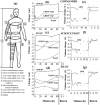Microgravity-induced fluid shift and ophthalmic changes
- PMID: 25387162
- PMCID: PMC4284461
- DOI: 10.3390/life4040621
Microgravity-induced fluid shift and ophthalmic changes
Abstract
Although changes to visual acuity in spaceflight have been observed in some astronauts since the early days of the space program, the impact to the crew was considered minor. Since that time, missions to the International Space Station have extended the typical duration of time spent in microgravity from a few days or weeks to many months. This has been accompanied by the emergence of a variety of ophthalmic pathologies in a significant proportion of long-duration crewmembers, including globe flattening, choroidal folding, optic disc edema, and optic nerve kinking, among others. The clinical findings of affected astronauts are reminiscent of terrestrial pathologies such as idiopathic intracranial hypertension that are characterized by high intracranial pressure. As a result, NASA has placed an emphasis on determining the relevant factors and their interactions that are responsible for detrimental ophthalmic response to space. This article will describe the Visual Impairment and Intracranial Pressure syndrome, link it to key factors in physiological adaptation to the microgravity environment, particularly a cephalad shifting of bodily fluids, and discuss the implications for ocular biomechanics and physiological function in long-duration spaceflight.
Figures












References
-
-
This cephalad shifting of fluid from the extremities toward the head is often referred to as the “cephalad fluid shift” in the spaceflight community.
-
-
- LeBlanc A., Schneider V., Shackelford L., West S., Oganov V., Bakulin A., Voronin L. Bone mineral and lean tissue loss after long duration space flight. J. Musculoskelet. Neuronal Interact. 2000;1:157–160. - PubMed
-
- LeBlanc A., Lin C., Shackelford L., Sinitsyn V., Evans H., Belichenko O., Schenkman B., Kozlovskaya I., Oganov V., Bakulin A., et al. Muscle volume, MRI relaxation times (T2), and body composition after spaceflight. J. Appl. Physiol. 2000;89:2158–2164. - PubMed
Publication types
LinkOut - more resources
Full Text Sources
Other Literature Sources
Research Materials

